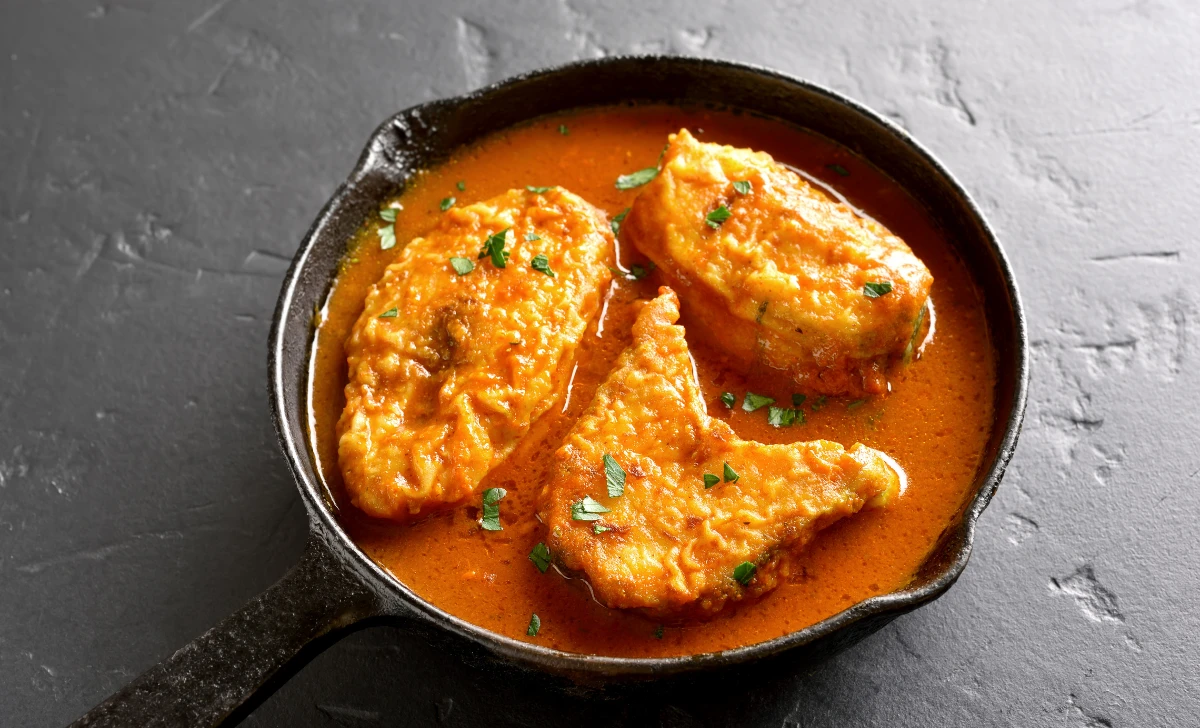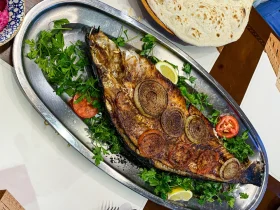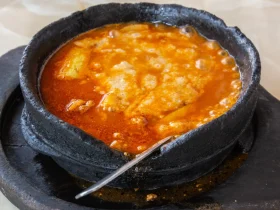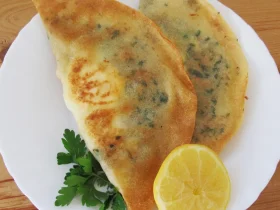Are you ready to embark on a culinary adventure that will tantalize your taste buds? If you’re a fan of seafood and crave bold flavors, look no further than the irresistible world of fish curry. Whether you’re a seasoned chef or a kitchen newbie, this fish curry recipe is bound to become your go-to dish for every occasion. Get ready to dive into a sea of flavors and learn how to create a fish curry that will have your friends and family begging for seconds!
[ez-toc]
History
The tantalizing aroma of fish curry has a history as rich and diverse as the flavors it brings to the table. As we take a journey through time, we’ll uncover how this beloved dish evolved from humble beginnings to become a global culinary sensation.
Ancient Origins and Coastal Beginnings
The roots of fish curry can be traced back to coastal communities that thrived on the bounties of the sea. Early civilizations, from the coastal regions of India to Southeast Asia, harnessed the ocean’s gifts to create flavorful dishes. Fish, being a readily available source of sustenance, was often prepared with locally grown spices and ingredients. These ancient fish curries were simple yet flavorful, a testament to the resourcefulness of these communities.
Spices and Trade: The Birth of Fusion
As trade routes expanded and cultures mingled, so did culinary influences. The Silk Road and maritime trade brought spices from distant lands to the shores of different regions. These exotic spices – cardamom, cumin, turmeric, and more – found their way into fish curry pots, transforming the dish into a tantalizing blend of flavors. The fusion of local ingredients with these newly introduced spices gave birth to variations that reflected each region’s unique identity.
India: A Spicy Affair
India, with its vast coastline and diverse culinary traditions, played a pivotal role in shaping fish curry’s journey. The coastal states of Kerala, Goa, and Bengal each developed their distinct styles of fish curry. In Kerala, the use of tangy tamarind and coconut milk added depth to the flavors. Goan fish curry boasted a fiery punch, a legacy of Portuguese influence. In Bengal, mustard seeds and the delicate balance of sweetness and heat set their fish curry apart.
Southeast Asia: A Symphony of Tastes
Across Southeast Asia, fish curry took on different forms, reflecting the region’s vibrant cultures. Thai cuisine, famous for its balance of sweet, sour, spicy, and salty, crafted curries that were aromatic and unforgettable. The Thai green curry, with its fresh herbs and chilies, became a sensation. In Malaysia and Indonesia, fish curry was often made with a base of lemongrass and turmeric, creating a melody of fragrances and tastes.
Modern Era: From Tradition to Fusion
As the world became more interconnected, the boundaries of culinary exploration expanded. Chefs and home cooks alike began to experiment, infusing fish curry with innovative twists. Fusion cuisines emerged, marrying traditional recipes with global ingredients. Chefs introduced ingredients like mango, pineapple, and even saffron, transcending cultural confines to create new sensations.
The Global Palate: Fish Curry’s International Journey
Today, fish curry has achieved international acclaim, gracing menus from local eateries to Michelin-starred restaurants. Food enthusiasts around the world have embraced its rich history and endless possibilities. From the bustling streets of Bangkok to the elegant dining rooms of Paris, the aroma of fish curry continues to evoke a sense of adventure, connecting people through their shared love for bold flavors and culinary exploration.
Time
| Step | Time |
|---|---|
| Marination | 1 hour |
| Sautéing onions, garlic, and ginger | 10 minutes |
| Adding tomatoes and spices | 15 minutes |
| Incorporating coconut milk | 5 minutes |
| Allowing the curry to simmer | 20 minutes |
| Final preparation and serving | 10 minutes |
| Total Cooking and Preparation Time | 1 hour 1 min |
Ingredients
| Ingredients | Quantity |
|---|---|
| Fish fillets (cod, snapper, or halibut) | 2 fillets (approx. 200g each) |
| Yogurt | 1/4 cup |
| Lemon juice | 1 tablespoon |
| Turmeric powder | 1/2 teaspoon |
| Cumin powder | 1/2 teaspoon |
| Coriander powder | 1 teaspoon |
| Red chili powder | 1/2 teaspoon (adjust to taste) |
| Salt | To taste |
| Cooking oil | 2 tablespoons |
| Onions, finely chopped | 1 medium |
| Garlic, minced | 3 cloves |
| Ginger, minced | 1-inch piece |
| Green chilies, chopped | 2 (adjust to taste) |
| Tomatoes, chopped | 2 medium |
| Coconut milk | 1 cup |
| Fresh cilantro leaves, chopped | For garnish |
| Basmati rice or naan bread | For serving |
Enjoy your flavorful fish curry meal for two!
Directions
Step 1: Marination
- In a bowl, mix together yogurt, lemon juice, turmeric powder, cumin powder, coriander powder, red chili powder, and a pinch of salt.
- Coat the fish fillets generously with this marinade, ensuring they’re well-covered.
- Allow the fish to marinate for at least 1 hour in the refrigerator. This will infuse the fish with flavors and tenderize it.
Step 2: Sautéing Aromatics
- In a pan, heat cooking oil over medium heat.
- Add finely chopped onions and sauté until they turn golden brown.
- Stir in minced garlic and minced ginger, letting their aroma fill your kitchen.
- Introduce chopped green chilies to add a hint of spiciness.
Step 3: Creating Flavor Layers
- Toss in chopped tomatoes, allowing them to soften and meld with the sautéed mixture.
- Sprinkle a dash of salt to help the tomatoes break down and release their juices.
- Now is the time to add your bespoke blend of ground spices – turmeric, cumin, coriander, and a touch of red chili powder. Let the spices infuse the base with their aroma and depth.
Step 4: Adding Creaminess
- Pour in a luscious cup of coconut milk, stirring gently to create a creamy base.
- Allow the flavors to marry, creating a harmonious blend of spices and creaminess.
- Witness how the coconut milk rounds off the edges of the spices, giving your curry a luxurious texture.
Step 5: Simmering to Perfection
- Reduce the heat to low and let your curry simmer gently.
- Allow the curry to cook for about 20 minutes, letting the flavors meld and intensify.
- As you watch the curry transform, anticipate the moment when you’ll savor its rich aroma and taste.
Step 6: Final Preparation and Serving
- Your fish curry masterpiece is ready to be served.
- Arrange the fish fillets in serving plates, spooning the flavorful curry over them.
- Garnish with freshly chopped cilantro leaves for a burst of freshness and color.
- Serve your fish curry with fluffy basmati rice or warm naan bread, offering the perfect companions for this culinary journey.
With these steps, you’ve mastered the art of creating a fish curry that’s not just a meal but an experience. Share this delightful dish with your companion and let the flavors transport you to a world of culinary ecstasy.
Equipment Required
Nutrition Information
| Nutrition Information | Per Serving |
|---|---|
| Serving Size | 1 serving |
| Calories | 300 kcal |
| Total Fat | 15g |
| – Saturated Fat | 8g |
| Cholesterol | 50mg |
| Sodium | 500mg |
| Total Carbohydrates | 12g |
| – Dietary Fiber | 2g |
| – Sugars | 4g |
| Protein | 28g |
| Vitamin D | 10% DV |
| Calcium | 6% DV |
| Iron | 15% DV |
| Potassium | 20% DV |
Please note that the nutrition information provided is approximate and can vary based on factors such as ingredient brands and portion sizes.
Tips
- Freshness is Key: Opt for fresh fish with firm white flesh. The oceanic aroma should transport you to the sea – if it doesn’t, the fish might not be at its best.
- Marinate Mindfully: While an hour of marination is sufficient, longer marination intensifies flavors. But be cautious – excessive marination might overpower the delicate taste of fish.
- Sauté with Care: Sauté onions until they achieve a golden hue. This caramelization adds depth to your curry’s flavor profile.
- Patience Pays Off: Let onions, garlic, ginger, and tomatoes meld and soften. This slow process is the foundation of the curry’s taste.
- Creaminess Control: Adjust the amount of coconut milk based on your preference. More coconut milk makes it creamier, while less gives a bolder spice kick.
Pros & Cons
| Pros | Cons |
|---|---|
| ✔️ Bursting with bold flavors | ❌ Requires marination time |
| ✔️ Versatile – works with various fish and spices | ❌ May be too spicy for some palates |
| ✔️ Infuses essential nutrients from fish | ❌ Coconut milk may not suit all dietary preferences |
| ✔️ Opportunity for creative variations | ❌ Preparation process involves multiple steps |
| ✔️ Culinary journey with a rich history | ❌ Cooking time might not suit those in a rush |
Conclusion
As we draw the curtains on our flavorful journey through the world of fish curry, it’s clear that this dish is not just a recipe; it’s an experience that tantalizes your senses and connects you with a rich culinary history. From marinating the fish to allowing the curry to simmer, each step is a symphony of flavors waiting to be conducted by your creative touch.
The beauty of fish curry lies in its versatility – a canvas where you can paint your own culinary masterpiece. Whether you’re an adventurous cook looking to experiment with spices or a comfort-food enthusiast craving the warmth of bold flavors, this recipe has something for everyone.
So why not don your apron, gather your spices, and embark on this flavorful adventure? Let the aroma of sautéed onions and simmering curry transport you to distant shores and bustling markets. With every bite, you’ll savor not just the taste but the stories woven into each ingredient and technique.
As you prepare and savor this fish curry, you’re not just enjoying a meal; you’re embracing a tradition that has evolved and adapted over centuries. It’s an opportunity to engage your senses, explore new flavors, and create a culinary masterpiece that reflects your unique taste.
So, gather your ingredients, follow the steps, and immerse yourself in the enchanting world of fish curry. As you take that first bite, you’re not just tasting food – you’re tasting history, culture, and the magic of culinary artistry. Bon appétit! 🍽️🐟🌶️
Facts
- Fact 1: A Spicy Love Story 🌶️
- Did you know that the spiciness of fish curry has more to offer than just a fiery kick? Spices like chili peppers actually contain compounds that can stimulate endorphins – your body’s natural “feel-good” chemicals. So when you’re savoring that zesty fish curry, you’re not just enjoying a meal; you’re treating yourself to a dose of culinary happiness!
- Fact 2: Pirates’ Spice of Choice 🏴☠️
- In the 18th century, fish curry played an unexpected role in maritime history. Pirates and sailors often relied on the potent flavors of curry to mask the taste of not-so-fresh fish during long sea voyages. So the next time you’re savoring your fish curry, remember – you’re indulging in a taste that once sailed the high seas!
- Fact 3: Evolution of Spice Routes 🌍
- Fish curry’s journey is closely tied to the history of spice trade routes. As traders and explorers traveled the world, they exchanged not just spices, but also culinary techniques. The blending of flavors from different cultures gave birth to the diverse fish curry variations we cherish today – a global symphony of taste!
- Fact 4: The “Accidental” Innovations 🧪
- Some of the most beloved variations of fish curry were born out of happy accidents. Legend has it that the Thai green curry, now a culinary icon, was created when a Thai chef decided to “greenify” a failed red curry experiment. It’s a delicious reminder that even in the kitchen, mistakes can lead to extraordinary discoveries.
- Fact 5: A Curry for Every Climate ☀️❄️
- Fish curry isn’t bound by geography – it adapts to the climate! In colder regions, hearty ingredients like tomatoes and warming spices dominate, while tropical areas lean towards coconut-infused creaminess. Fish curry proves that no matter where you are, you can enjoy a bowl of culinary comfort tailored to your surroundings.
FAQ’s
Can I use frozen fish for the curry?
Yes, frozen fish can work well. Thaw it thoroughly before marination for the best results.
How spicy will the curry be?
The level of spiciness is adjustable. Control the heat by modifying the amount of red chili powder and green chilies.
Can I substitute coconut milk with something else?
Certainly! While coconut milk adds a unique creaminess, you can use heavy cream or yogurt for a different taste.
What side dishes complement fish curry?
Opt for refreshing sides like cucumber mint raita or tangy mango chutney to balance the flavors.
Any tips for beginners attempting fish curry?
Start with a milder spice blend and gradually experiment with bolder flavors as you become more comfortable.
Can I use a different type of fish?
Absolutely! Choose firm white fish like cod, snapper, or halibut for best results. Adjust cooking time as needed.
How can I make the curry less oily?
You can reduce the amount of oil used in sautéing and use light coconut milk for a healthier option.
Is this recipe suitable for vegetarians?
You can create a vegetarian version by substituting fish with tofu or mixed vegetables. Adjust the cooking time accordingly.
Can I make the curry ahead of time?
Yes, you can prepare the curry ahead and reheat it gently before serving. This often enhances the flavors.
How can I adjust the portion size for more servings?
Simply multiply the ingredient quantities based on the number of servings you need. Keep in mind that cooking times might vary slightly.












Leave a Review